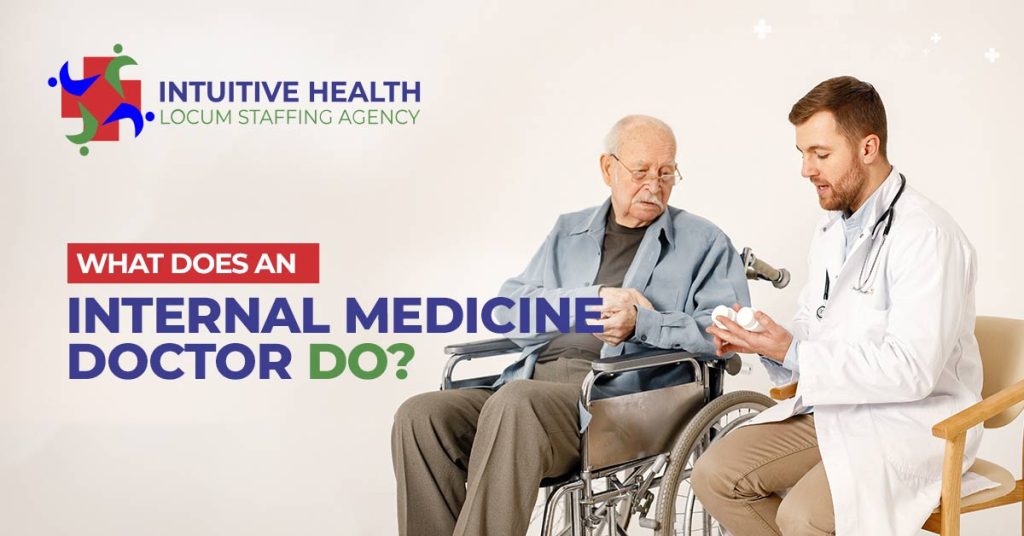Chronic diseases may feel harmless for some period of time, but they are not. Chronic diseases need more care and preventive measures to ensure that the patient’s health is sustained. However, patients can’t take care of their chronic condition unless they take advice, treatment, and a diet plan from the doctors. In healthcare, the primary physicians are our advisers as they treat our conditions and diseases and help us live better lives.

Internal medicine doctors play a central role in patient care by diagnosing, managing, and preventing complex adult health conditions. Their expertise lies in understanding how the body’s systems interact, making them essential in providing long-term and comprehensive healthcare for adults. In this blog, we will explain who internal medicine doctors are, what responsibilities they perform, and how patients can benefit from their care.
What Is an Internal Medicine Doctor?
An internal medicine doctor is a physician trained to provide expertise in the prevention, diagnosis, and treatment of diseases in adults. Their training and skills emphasize how different systems of the body connect, allowing them to manage both common and complex illnesses. Internal medicine doctors are also commonly known as internists or internal medicine physicians.
Internal medicine physicians and their treatments are not limited to one organ system; instead, they provide a holistic approach to patient care. Whatever ailment or disease a patient has, they always take the appointment and treatment from an internist.
Difference Between an Internist and a Family Physician
Before understanding the role of an internist, one must understand the hierarchy of physicians. Many times, people often get confused between an internal medicine physician and a family physician. So, let’s understand thoroughly how they differ from each other:
General Physician
A general physician is a doctor who is a primary care provider who diagnoses, treats, and provides preventive care to all patients. They are the first point of contact for patients in case of emergencies, illness, and annual checkups. Physicians only provide treatment through medicines, diet, and lifestyle changes that help patients recover from their illness or prevent it in the near future. Physicians treat patients differently from surgeons.
Suggested Read: Physician vs Surgeon: What Is the Difference?
Whereas both internal medicine physicians and family physicians fall under the category of general physicians, meaning they provide primary care to patients. However, their focus on patients and training differs:
Internal Medicine Doctor
An internist specializes in adult care. They deal with patients from young adulthood through old age. They provide care and treatment to teenage patients and older patients. Their expertise is in managing chronic illnesses, complex conditions, and multi-system diseases, as well as preventive care. They are highly trained to handle hospitalized patients as well.
Family Physician
A family physician provides care to patients of all ages, with the age bracket ranging from infants to older adults. Their training covers pediatrics, obstetrics, and geriatrics alongside adult medicine. Family physicians address general wellness, preventive medicine, and family-based care across generations.
In simple words, internists specialize in adult medicine, while family physicians focus on whole-family care across all age groups. Both are general physicians, but their training paths and patient populations differ.
Specialties of Internal Medicine Doctors
Internal medicine doctors can either practice as general internists or pursue specialties to keep their practice focused on a certain area of diagnosis and treatment. After choosing a specialty, internists only provide care and treat illnesses of patients in their area of expertise.
Some common specialties include:
- Cardiology: This specialty is focused on heart and vascular diseases.
- Endocrinology, Diabetes and Metabolism: This field specializes in endocrine glands, hormones, and metabolic disorders, including diabetes and thyroid disease.
- Gastroenterology: In this specialty, internal medicine doctors concentrate on digestive system disorders and treat liver and gallbladder issues.
- Infectious Disease: The expert in this field manages complex bacterial, fungal, viral, and parasitic infections, including those resistant to treatment.
- Pulmonology: In this specialty, an internal medicine physician specializes in lung and respiratory diseases.
- Rheumatology: This specialty focuses on autoimmune and musculoskeletal conditions such as arthritis.
- Nephrology: In nephrology, the healthcare expert concentrates on kidney health and its related diseases.
- Geriatric Medicine: This specialty focuses on providing care and treatment of older adults and their medical issues.
- Hematology: This field is linked with the diseases of the blood, spleen, and lymph nodes, including anemias and clotting disorders.
- Oncology: In this specialty, internal medicine doctors use drugs and treatments to treat and manage cancer.
Suggested Read: Work-Life Balance in Health Department Jobs: Is It Possible?
Responsibilities of an Internal Medicine Physician
Internists provide both preventive care and treatment of illnesses in adult patients. However, it is important to understand how internal medicine physicians perform their treatment to cure conditions and diseases in patients. So, on a daily basis, internists have the following responsibilities:
Diagnosing and Managing Diseases
Before treating any condition or disease, it is first important to diagnose it properly. Internists evaluate the symptoms of the patients and order diagnostic tests to confirm the real issue or cause of the ailment, and then create personalized treatment plans for patients.
Managing Chronic Illnesses
According to the US Centers for Disease Control and Prevention, 11.6% of the population in the USA was suffering from diabetes. Diabetes, also commonly known as sugar, is a long-term disease that needs care from a specialized physician. Internal medicine doctors with an endocrinology specialty provide long-term care and treatment for patients with diabetes. Similarly, patients having other chronic diseases like hypertension and asthma also manage their health with routine checkups with internists.
Providing Preventive Care
Internists also provide preventive care to patients. They conduct health screenings, order or administer vaccinations, share diet plans, and advise lifestyle changes and counseling to help patients reduce disease risks in the future. Preventive care is also a part of treatment provided by doctors.
Coordinating Specialist Care
Not all conditions and diseases are managed and cured by a general physician. In case of a serious patient condition, the internists run proper diagnostic tests to figure out the disease and its effect on the patient’s health. Then internists coordinate care with other internal medicine doctors, with the particular specialty of the patient’s problem, and the internist specialist will manage and provide treatment to the patient. Similarly, the internal medicine physician also coordinates with surgeons and completes the treatment care of patients who need surgery.
Patient Care in Hospital
Other than routine visits and checkups for an ailment, internal medicine doctors also provide ongoing treatment and care to patients. In a slightly serious condition, if the patient is hospitalized, then internists ensure continuity of treatment from admission to recovery.
Suggested Read: The Essential Skills Needed for Health Department Jobs
When Should a Patient See an Internist?
It is clear that for any issue, patients should always visit an internal medicine doctor for a thorough checkup. But it is also important to know when the right time is to visit and take the doctor’s advice and treatment. So, patients should consider visiting an internist in several situations, such as below:
- General Check-Ups: For regular health maintenance, patients should visit the internal medicine doctor for health screenings and preventive care.
- Chronic Illness Management: When dealing with conditions like hypertension, diabetes, or cardiovascular disease, it is best to stay and visit the internist for proper management of the long-term disease..
- Unexplained Symptoms: In case of sudden ailment or unclear symptoms that require in-depth analysis and immediate treatment, the patient should visit the internist.
- Complex Medical Conditions: If a patient has multiple conditions that require careful coordination of care, then having routine checkups with an internal medicine doctor is the right choice.
- Specialist Referrals: When a patient needs advanced treatment for their illness or condition, an internist guides them to the right subspecialist to complete the treatment.
How to Become an Internist in the USA
In the United States of America, there is a shortage of primary care physicians. Therefore, in the past decades, the internal medicine primary care residency programs were expanded. According to a survey by the National Library of Medicine, the expansion of internal medicine residency programs created more encouragement for students, and over half of students in 2016 and 2017 chose primary care in their residency period. So, as there is always a greater need for internists in the USA, to pursue this career, a student has to complete the following requirements:
Earn a Bachelor’s Degree
The first requirement for students is to complete an undergraduate degree. So, students take admission in a pre-medical bachelor’s degree with courses in biology, chemistry, and related sciences. This is the foundational stage of learning about medical sciences.
Complete Medical School
The next step is to take admission in the medical school. Students have to earn a Doctor of Medicine (MD) or Doctor of Osteopathic Medicine (DO) degree. This is a four-year degree program that is divided into two stages. In the preclinical stage, students learn about human anatomy, biochemistry, pathology, pharmacology, physiology, and principles of medicine. In the clinical stage, students complete rotations in different specialties like internal medicine, pediatrics, psychiatry, surgery, gynecology, obstetrics, and family medicine. to gain experience in treating patients.
Take Residency Training
After medical school, students have to apply for the residency program. A three-year internal medicine residency program focusing on adult healthcare in outpatient clinics and hospitals equips students with practical knowledge and experience to treat and provide care for patients.
Earn the License of Internist
When students complete their residency period, they have to officially prove themselves as licensed doctors. Therefore, to become an internal medicine physician, students have to pass the exam from the American Board of Physician Specialties and earn their official doctoral license.
Optional Fellowship for Further Specialization
Once students earn their official internal medicine doctor license, they have the option to study further and become an expert in a subspecialty. So, after taking the license, students can complete an additional two to three years of training to become a physician in a subspeciality, e.g., cardiology, gastroenterology, or infectious disease, etc.
Essential Role of Internal Medicine in Adult Care
Primary care providers like internal medicine doctors offer preventive care, diagnosis, treatment, and long-term management care services to patients. While both internists and family physicians provide primary care, internists focus exclusively on adult patients. They can also pursue a further fellowship program to specialize in a particular subspecialty. By understanding the real role of the internal medicine doctor, patients can make informed decisions about when to seek care from an internist and appreciate the vital role these physicians play in maintaining health across adulthood.
Are you looking for a better opportunity as an internal medicine doctor? Then contact Intuitive Health Services, which provides medical staffing solutions across various medical fields, and help you find your next best opportunity.

